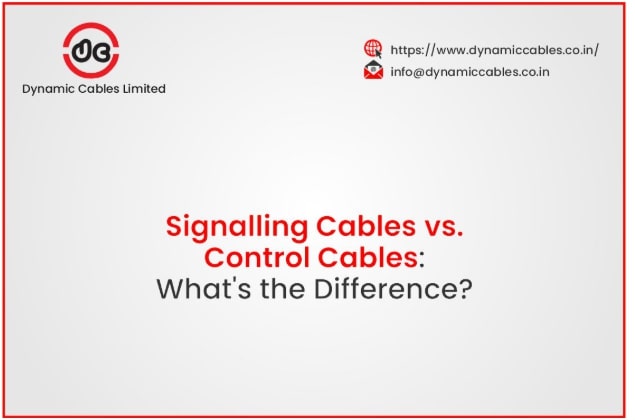- An ISO 9001:2015, 14001:2015 & 45001:2018 Company

Signalling Cables vs. Control Cables: What's the Difference?
In the complex universe of electrical wiring, cables are the essential conduits for carrying power and information. Two such cables that confuse people are signaling and control cables. Although both are critical components in industrial and automation systems, their function, design, and usage differ. Engineers, technicians, and anyone dealing with electrical installations must know these differences. Let's discuss the significant differences among these types of cables, as described by top electrical cable wire manufacturers such as Dynamic Cables and top cable makers of India.
In essence, signaling cables are intended to carry low-voltage electrical signals for data exchange and communication. The signals are normally employed to exchange information among system components, like sensor outputs, feedback signals, and low-level control commands. The primary concern of a signaling cable is the transmission of such signals accurately and dependably, generally over comparatively short distances.
In terms of construction, signaling cables usually have several cores (conductors) of copper, which provide superior conductivity for signal integrity. The cores typically have a smaller cross-sectional area since they are not designed to handle large amounts of power. To reduce interference and provide signal clarity, signaling cables usually have shieldings, such as braided copper or aluminum foil, that prevent the transmitted signals from electromagnetic interference (EMI) and radio frequency interference (RFI). The insulation material is selected based on its electrical and flexibility characteristics. Although some signaling cables possess a simple outer sheath for moisture and abrasion protection, they do not have heavy armoring.
Typical uses of signaling cables are for sensor-to-control unit connections, data transmission in automation systems, audio and video signal carrying, and communication in security systems. They are the nervous system of most automated processes, transmitting vital information that allows machines and systems to function intelligently.
Conversely, control cables convey electrical energy to control circuits and devices. These cables represent the voltage and current required for relays, contactors, solenoid valves, small motors, and other control equipment to work. Though they also convey signals, the foremost function of a control cable is to supply the power needed to operate such devices.
Armored control cable is a generic variant carefully developed for high-performance industrial situations requiring mechanical safeguarding. Armaments usually have a steel wire/strip armour, steel wire braid or tape covering the inner cores and insulation. Such armor offers significant protection against physical damage, abrasion, impacts, and attacks by rodents to guarantee the power supply's safety to essential control units. The armored control cable outer sheath is typically constructed of a rigid material such as PVC or polyurethane to offer additional protection against the environment.
The construction of control cables comprises several copper conductors, usually having a higher cross-sectional area than signaling cable, to carry the necessary current. The insulation materials are selected for their electrical strength, heat, and chemical resistance. Though there might be shielding in some control cables to reduce electromagnetic interference, it is not as widely present as in signaling cables, particularly for the transmission of power.
Control cables have extensive applications in industrial automation, machinery control, power plants, and building management systems. They supply the power that drives the control devices, which regulate various processes and devices. The application of armored control cable is most common in severe industrial environments, underground, and outdoor applications where the cable is subject to possible mechanical stress. Reliable Indian cable manufacturers like Dynamic Cables provide standard and armored control cable solutions for various industrial requirements.
Essentially, the most basic difference is in their initial purpose. Signaling cables are messengers that transmit low-power signals for communication and data. They focus more on signal integrity and tend to include shielding. Their conductors are usually smaller since they do not have to carry significant currents. Control cables, on the other hand, are the power suppliers for control equipment. Their primary function is to supply the required voltage and current to drive these elements. They tend to have more prominent conductors and, in harsh environments, are often armored for mechanical protection.
Thus, when choosing cables for a particular application, deciding if the main requirement is the conveyance of low-level signals or the supply of power to drive equipment is essential. Awareness of this fundamental difference between signaling cable and control cable and the heavy-duty nature of armored control cable will allow the right choice of cable to be made for safe and effective operation. Top electrical cable wire manufacturers such as Dynamic Cables provide specialized knowledge and a full array of control cables and railway signaling cables to cater to the varied needs of contemporary electrical systems.
 English
English

 C701, Tower-C, Noida One
C701, Tower-C, Noida One
